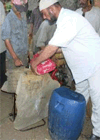Chlorpyrifos exposures in Egyptian cotton field workers
- PMID: 20193710
- PMCID: PMC3580798
- DOI: 10.1016/j.neuro.2010.02.005
Chlorpyrifos exposures in Egyptian cotton field workers
Abstract
Neurobehavioral deficits have been reported in Egyptian pesticide application teams using organophosphorus (OP) pesticides, but whether these effects are related to OP pesticide exposures has yet to be established. In preparation for a comprehensive study of the relationship between OP pesticide dose and neurobehavioral deficits, we assessed exposure within this population. We conducted occupational surveys and workplace observations, and collected air, dermal patch and biological samples from applicators, technicians and engineers involved in chlorpyrifos applications during cotton production to test the hypotheses that: (1) dermal exposure was an important contributor to internal dose and varied across body regions; and (2) substantial differences would be seen across the three job categories. Applicators were substantially younger and had shorter exposure histories than did technicians and engineers. Applicators and technicians were observed to have relatively high levels of skin or clothing contact with pesticide-treated foliage as they walked through the fields. Both dermal patch loadings of chlorpyrifos and measurements of a chlorpyrifos-specific metabolite (TCPy) in urine confirmed substantial exposure to and skin absorption of chlorpyrifos that varied according to job category; and dermal patch loading was significantly higher on the thighs than on the forearms. These findings support our hypotheses and support the need for research to examine neurobehavioral performance and exposures in this population. More importantly, the exposures reported here are sufficiently high to recommend urgent changes in work practices amongst these workers.
Copyright 2010 Elsevier Inc. All rights reserved.
Conflict of interest statement
All authors have submitted conflict of interest statements to OHSU or their own University to indicate that they do not have a conflict of interest with respect to this submission.
Figures





Similar articles
-
Magnitude of behavioral deficits varies with job-related chlorpyrifos exposure levels among Egyptian pesticide workers.Neurotoxicology. 2020 Mar;77:216-230. doi: 10.1016/j.neuro.2020.01.012. Epub 2020 Jan 30. Neurotoxicology. 2020. PMID: 32006538 Free PMC article.
-
Occupational pesticide exposure and symptoms of attention deficit hyperactivity disorder in adolescent pesticide applicators in Egypt.Neurotoxicology. 2019 Sep;74:1-6. doi: 10.1016/j.neuro.2019.05.002. Epub 2019 May 8. Neurotoxicology. 2019. PMID: 31077682 Free PMC article.
-
Contributions of inhalation and dermal exposure to chlorpyrifos dose in Egyptian cotton field workers.Int J Occup Environ Health. 2012 Jul-Sep;18(3):198-209. doi: 10.1179/1077352512Z.00000000030. Int J Occup Environ Health. 2012. PMID: 23026005
-
Cancer among pesticide manufacturers and applicators.Scand J Work Environ Health. 2005;31 Suppl 1:9-17; discussion 5-7. Scand J Work Environ Health. 2005. PMID: 16190144 Review.
-
A review of pesticide exposure and cancer incidence in the agricultural health study cohort.Cien Saude Colet. 2012 Jan;17(1):255-70. doi: 10.1590/s1413-81232012000100028. Cien Saude Colet. 2012. PMID: 22218559 Review.
Cited by
-
Evaluation of occupational pesticide exposure on Egyptian male adolescent cognitive and motor functioning.Environ Res. 2021 Jun;197:111137. doi: 10.1016/j.envres.2021.111137. Epub 2021 Apr 9. Environ Res. 2021. PMID: 33839119 Free PMC article.
-
Allele and genotype frequencies of CYP2B6 and CYP2C19 polymorphisms in Egyptian agricultural workers.J Toxicol Environ Health A. 2012;75(4):232-41. doi: 10.1080/15287394.2012.641201. J Toxicol Environ Health A. 2012. PMID: 22352331 Free PMC article.
-
Longitudinal assessment of occupational exposures to the organophosphorous insecticides chlorpyrifos and profenofos in Egyptian cotton field workers.Int J Hyg Environ Health. 2015 Mar;218(2):203-11. doi: 10.1016/j.ijheh.2014.10.005. Epub 2014 Nov 7. Int J Hyg Environ Health. 2015. PMID: 25466362 Free PMC article.
-
Bioremediation of chlorpyrifos residues using some indigenous species of bacteria and fungi in wastewater.Environ Monit Assess. 2023 May 31;195(6):779. doi: 10.1007/s10661-023-11341-3. Environ Monit Assess. 2023. PMID: 37256360 Free PMC article.
-
Cytochrome P450-specific human PBPK/PD models for the organophosphorus pesticides: chlorpyrifos and parathion.Toxicology. 2011 Jul 11;285(1-2):57-66. doi: 10.1016/j.tox.2011.04.002. Epub 2011 Apr 13. Toxicology. 2011. PMID: 21514354 Free PMC article.
References
-
- Keifer M, McConnell R, Pacheco AF, Daniel W, Rosenstock L. Estimating underreported pesticide poisonings in Nicaragua. Am. J. Ind. Med. 1996;30:195–201. - PubMed
-
- Vergara AE, Fuortes L. Surveillance and epidemiology of occupational pesticide poisonings on banana plantations in Costa Rica. Int. J. Occup. Environ. Health. 1998;4:199–201. - PubMed
-
- Litchfield MH. Estimates of acute pesticide poisoning in agricultural workers in less developed countries. Toxicol. Rev. 2005;24:271–278. - PubMed
-
- Recena M, Pires D, Caldas E. Acute poisoning with pesticides in the state of Mato Grosso do Sul, Brazil. Sci. Total Environ. 2006;357:88–95. - PubMed
-
- Rodriguez T, Younglove L, Lu C, Funez A, Weppner S, Barr DB, Fenske RA. Biological monitoring of pesticide exposures among applicators and their children in Nicaragua. Int. J. Occup. Environ. Health. 2006;12:312–320. - PubMed
Publication types
MeSH terms
Substances
Grants and funding
LinkOut - more resources
Full Text Sources
Medical
Miscellaneous

